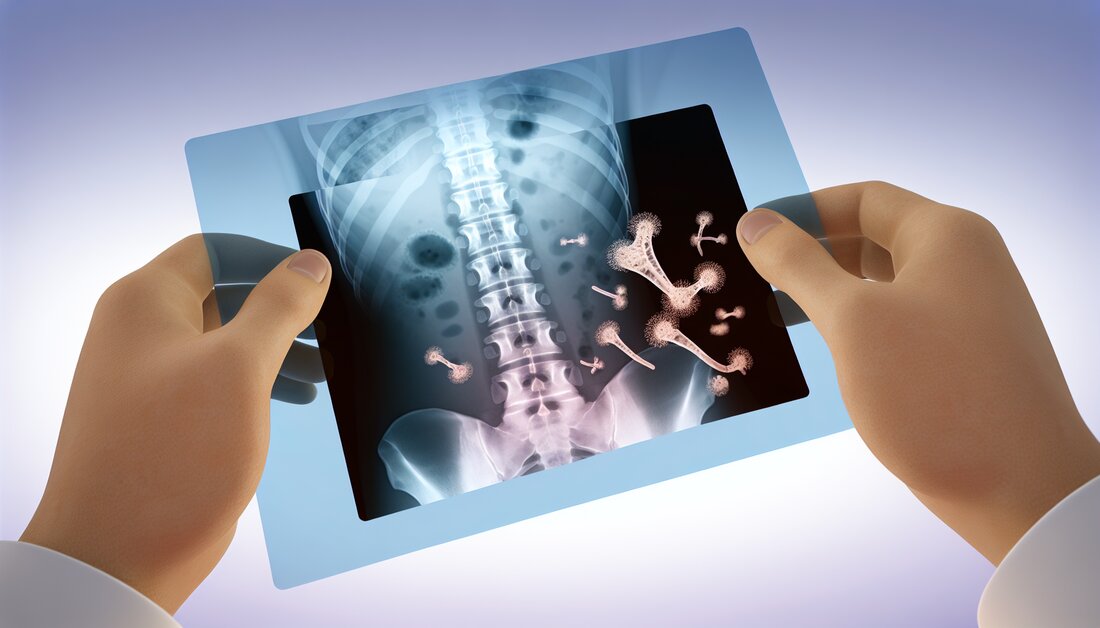Mysterious pain: diagnosing fungal endocarditis in back pain
A rare case of fungal endocarditis initially presenting with back pain. This report highlights the importance of thorough examinations for a correct diagnosis.

Mysterious pain: diagnosing fungal endocarditis in back pain
Heart valve infections caused by fungi are extremely rare and differ in some aspects from the more common bacterial heart valve infections. They develop more slowly and often show non-specific symptoms, making diagnosis difficult. A particularly unusual initial symptom is back pain, which can often lead to misdiagnosis or delays in proper diagnosis.
In the study presented, a 61-year-old man experienced recurrent back pain and fever over a two-month period. Without a history of invasive procedures or immunosuppression, fungal endocarditis (FE) was ultimately diagnosed. The man was treated surgically to remove the affected growth and replace the mitral valve. After surgery, he received full antifungal therapy and was symptom-free at one-year follow-up.
This case study highlights the importance of looking beyond superficial symptoms when diagnosing. Back pain as an initial symptom can lead to misinterpretations. A careful examination and targeted diagnostics are crucial for the correct treatment.
The traditional practice for back pain is often to view it as a muscular or mechanical problem, particularly in the elderly. However, this research highlights the need to also consider atypical causes, particularly when accompanying symptoms such as fever are present.
Basic terms and concepts
- Endokarditis: Eine Entzündung der Herzinnenhaut, oft durch Infektionen verursacht.
- Pilz-Endokarditis (FE): Spezielle Form der Endokarditis, hervorgerufen durch Pilze, die schwerer zu diagnostizieren ist als ihre bakterielle Variante.
- Mitralersatz: Operativer Eingriff zum Austausch der Mitralklappe des Herzens.
- Antifungale Therapie: Behandlung mit Medikamenten, die speziell gegen Pilzinfektionen wirken.
Abbreviations
- FE: Fungal Endocarditis (Pilz-Endokarditis)
Key insights into fungal endocarditis: diagnostic hurdles and treatment success
The present research examines the challenges in diagnosing and treating the rare but difficult to diagnose fungal endocarditis (FE). Due to its gradual progression and non-specific symptoms, such as back pain in particular, which can occur in conjunction with fever, there is a high risk of misdiagnosis or delayed diagnosis. A specific case led to relevant findings.
Study of the clinical case
- Patientenprofil: 61-jähriger männlicher Patient mit wiederkehrenden Rückenschmerzen und Fieber über einen Zeitraum von zwei Monaten.
- Klinische Herausforderungen: Keine Anamnese von invasiven Eingriffen oder immunsuppressiver Therapie, was die Diagnose von FE erschwerte.
Diagnostic process
The patient was ultimately diagnosed with fungal endocarditis. The diagnosis proved difficult because the initial symptoms such as back pain and fever did not directly indicate a cardiac cause. This highlights the need for comprehensive and precise clinical examinations as well as targeted diagnostic methods.
Therapeutic interventions and results
The patient underwent surgical treatment to remove the endocarditis outgrowth and undergo mitral valve replacement. He then received full antifungal therapy. The treatment led to a significant reduction in symptoms:
- Linderung der Rückenschmerzen: Postoperativ keine Rückenschmerzen mehr.
- Fieberfreiheit: Der Patient blieb nach der Operation fieberfrei und wurde nach Abschluss der antifungalen Therapie entlassen.
- Langzeitbeobachtung: Keine Rückkehr der Symptome nach einem Jahr Follow-up.
Scientific teachings
The case analyzed highlights the importance of not being deceived by superficial symptoms when making a diagnosis. It suggests that back pain associated with fever, particularly in cases without obvious risk factors, warrants more extensive investigations to rule out a serious condition such as fungal endocarditis. These findings could be crucial for improving diagnostic protocols and preventing misdiagnosis.
For further information and detailed results of the study, please visit the following link: PubMed entry.

 Suche
Suche
 Mein Konto
Mein Konto
